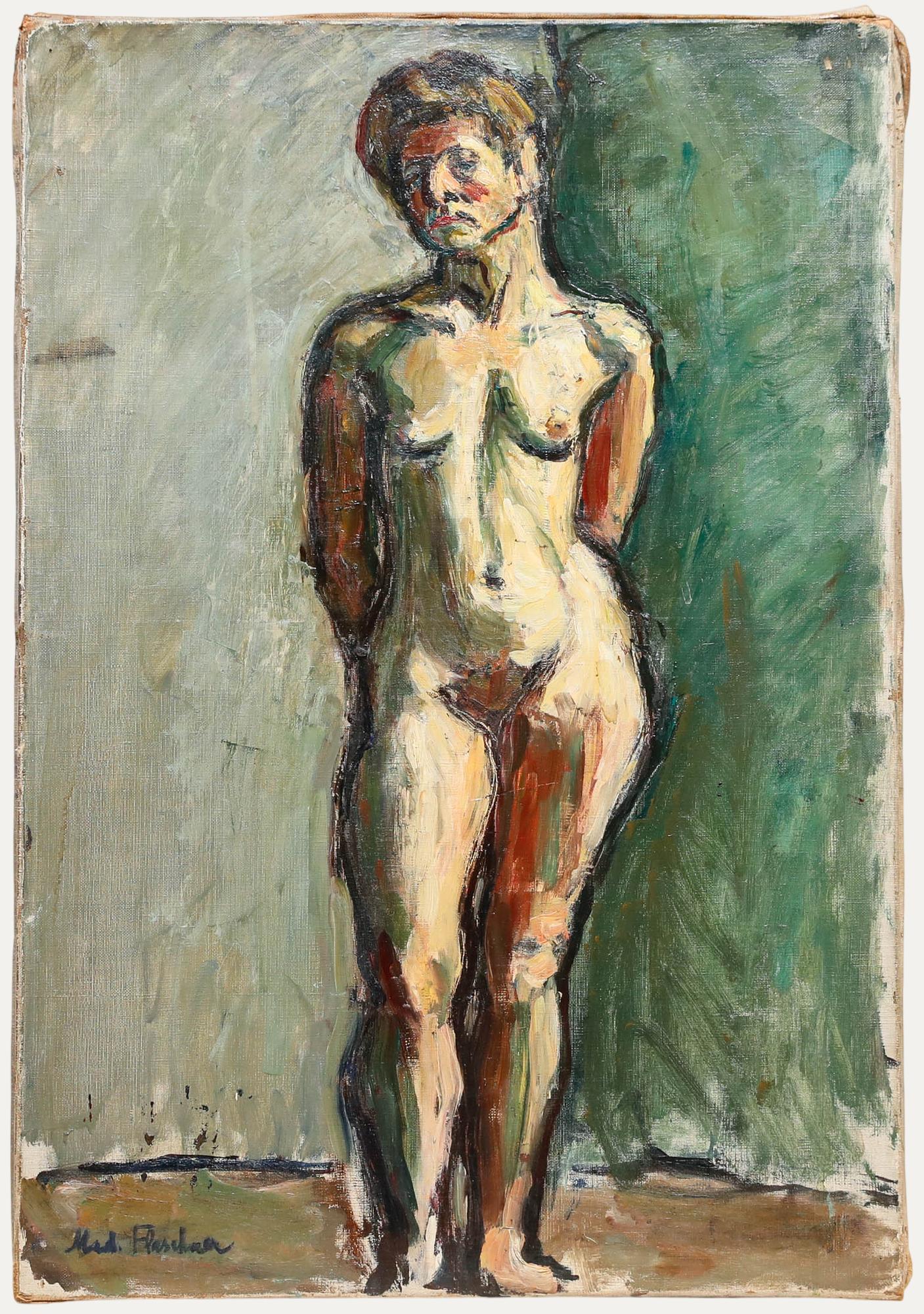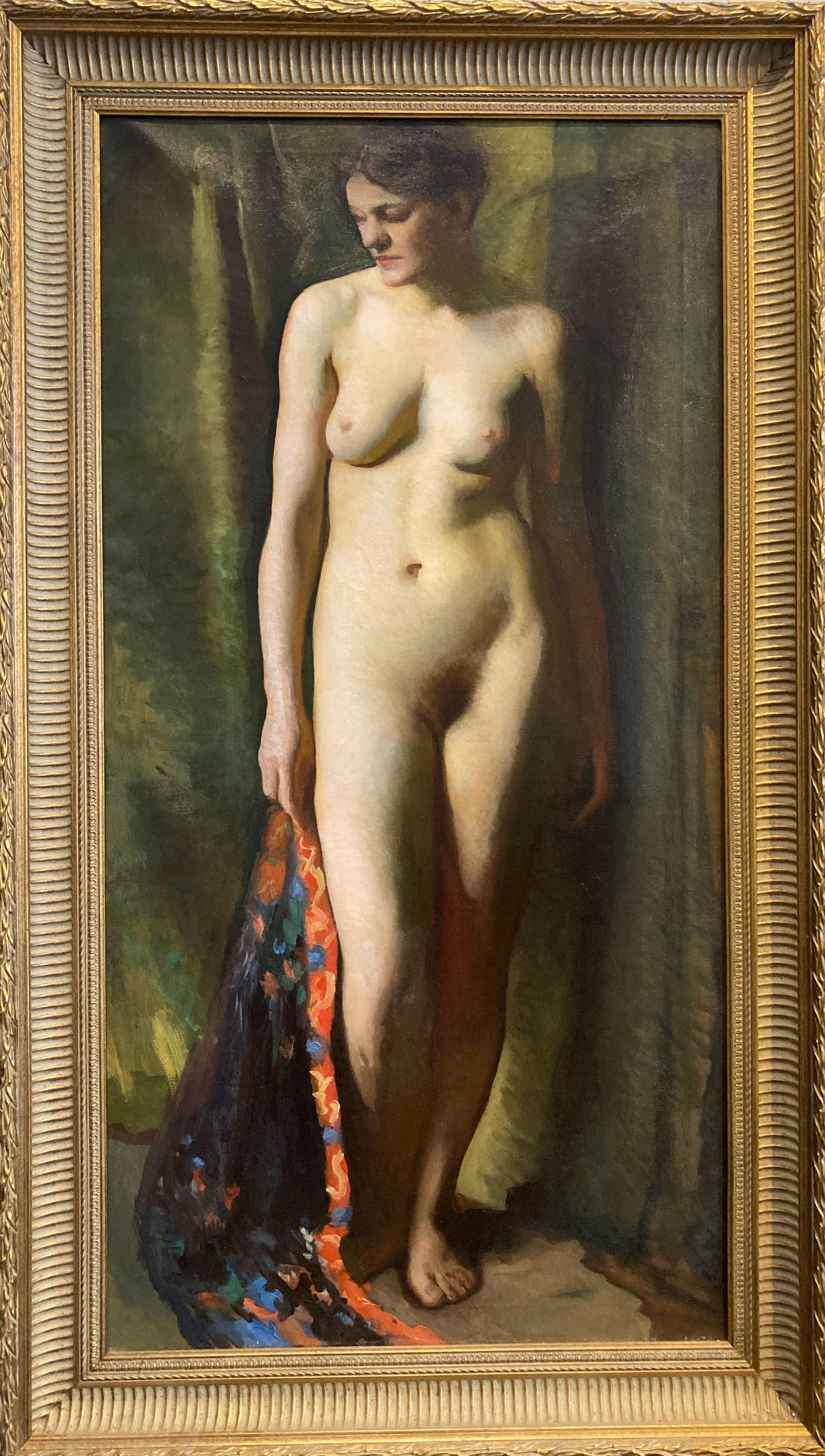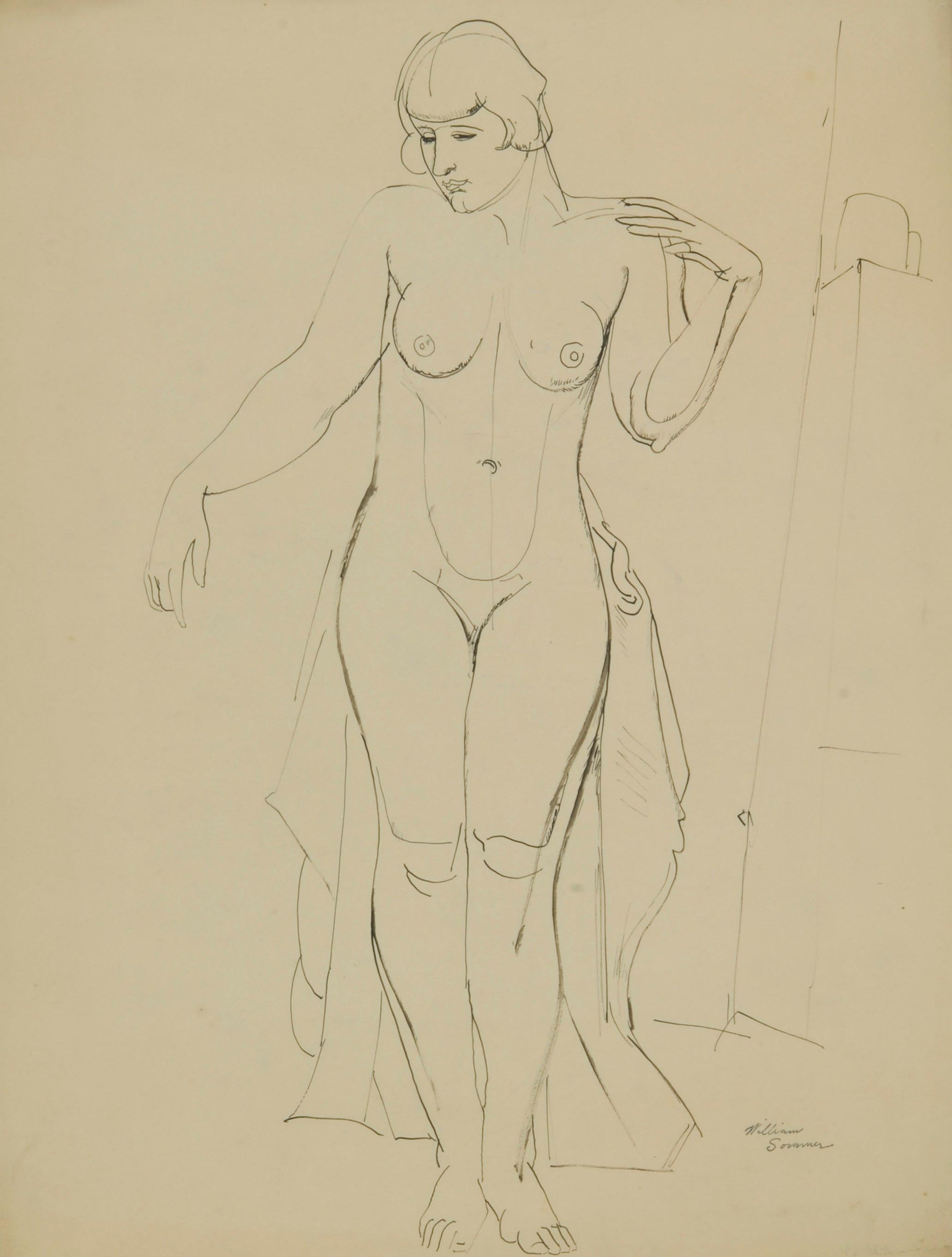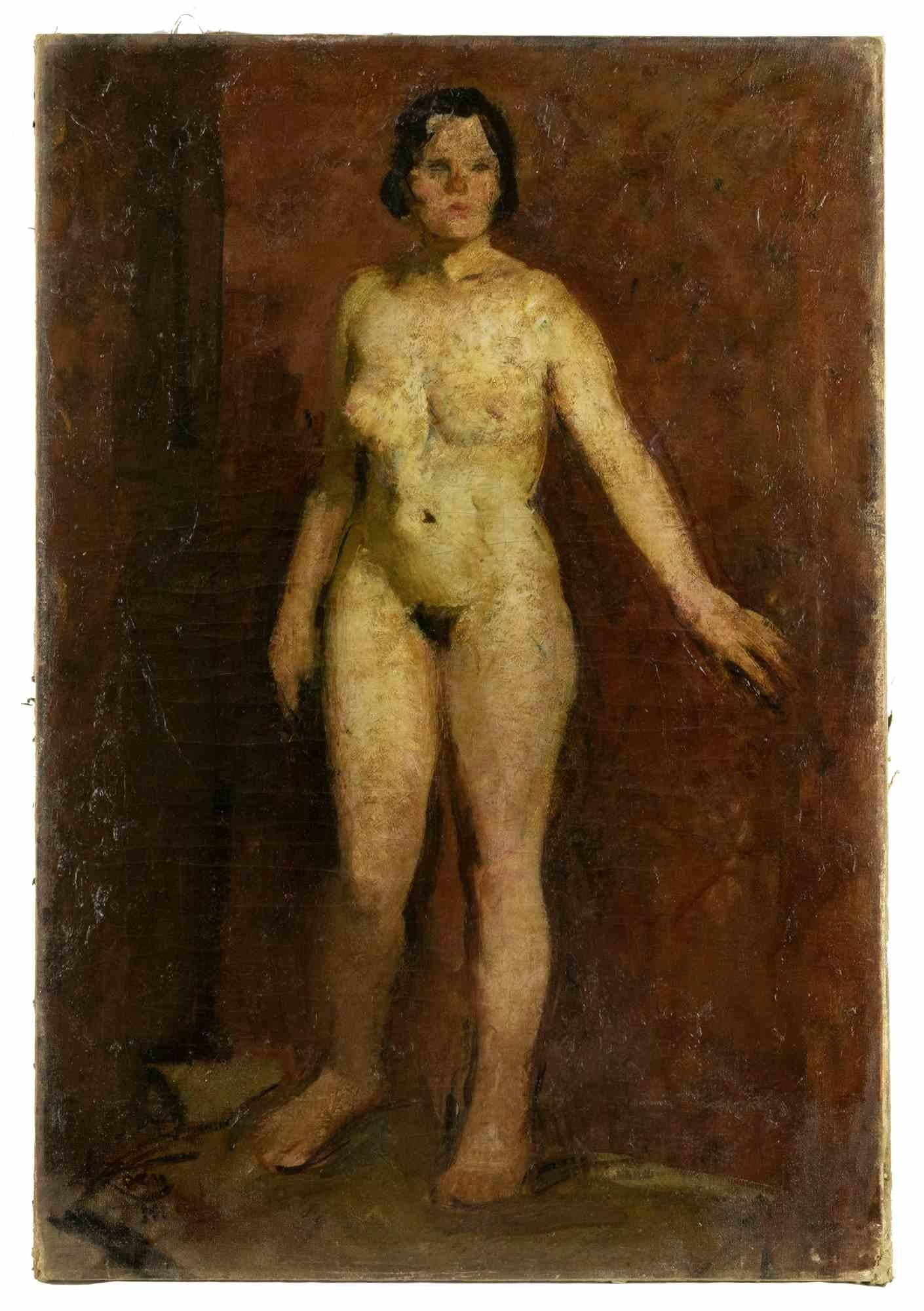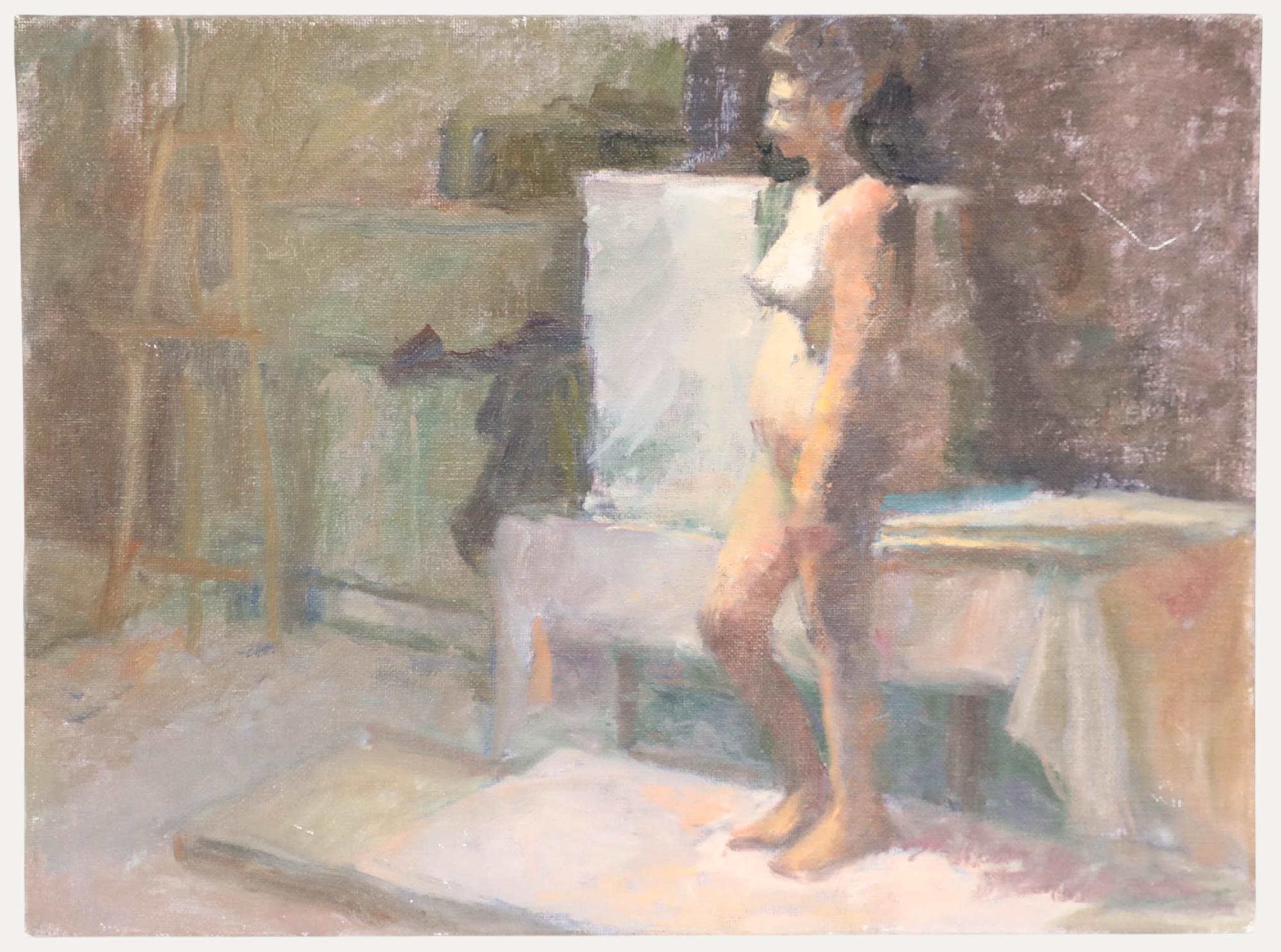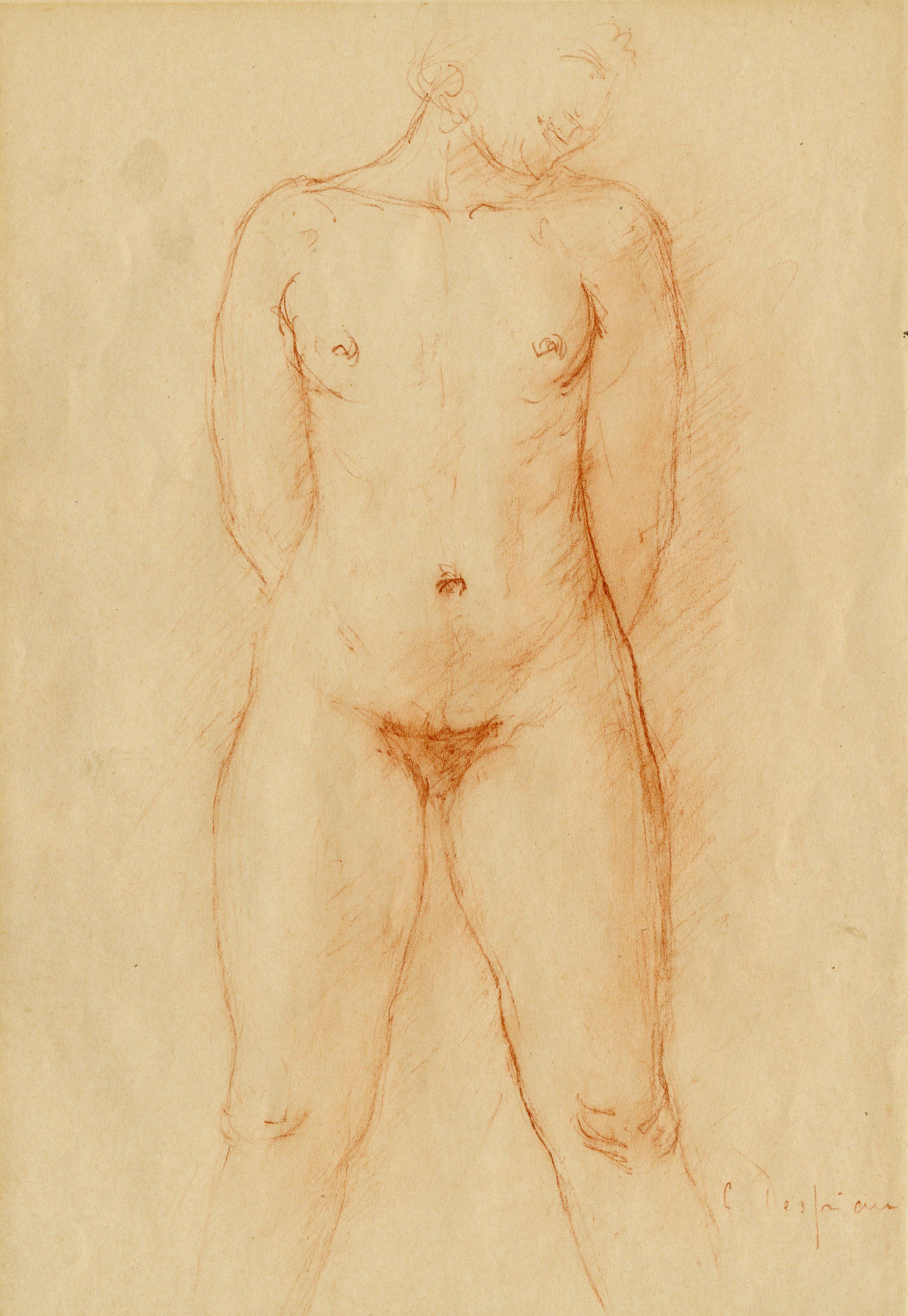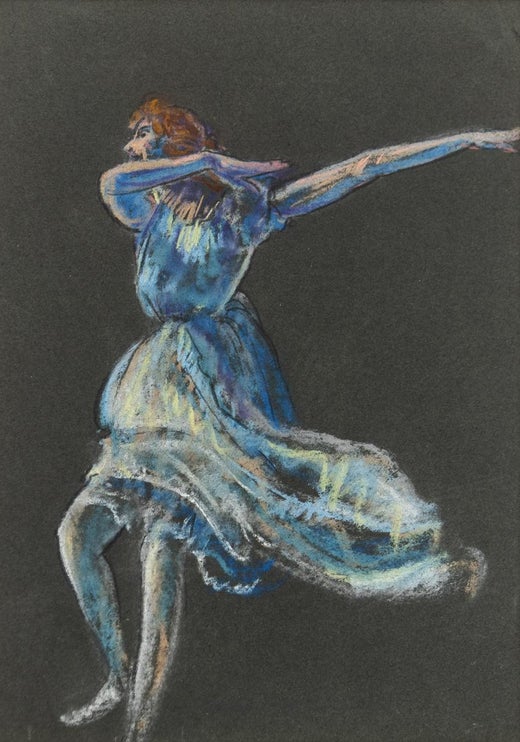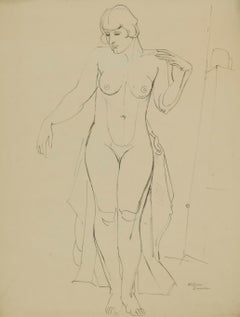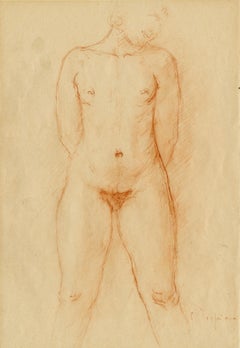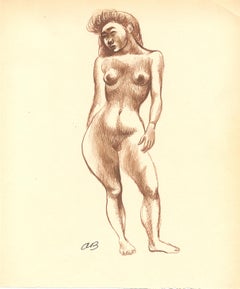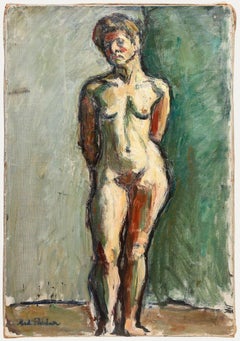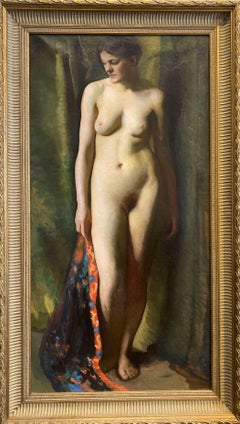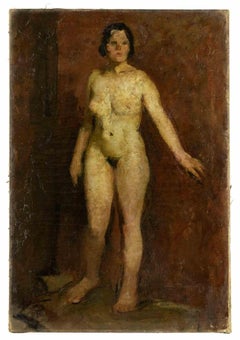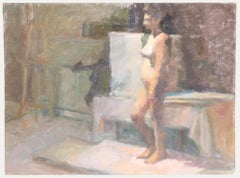Objekte ähnlich wie Stehender weiblicher Akt
Möchten Sie mehr Bilder oder Videos?
Zusätzliche Bilder oder Videos von dem*der Anbieter*in anfordern
1 von 12
Arthur Bowen DaviesStehender weiblicher Akt
8.693,89 €
Angaben zum Objekt
Standing Female Nude
Oil on canvas, c. 1910
Signed lower left corner (see photo)
Condition: Excellent
Housed in a 22K Gold Leaf Frame
Canvas size: 24 x 18 1/8 inches
Frame size: 30 x 24 inches
Provenance: Estate of the artist
James Graham & Sons, New York (agent for the artist and his estate)
Most probably a finished study for a central figure in a large allegorical painting.
Biography
Arthur B. Davies’s mystical, mysterious paintings hearken back to 19th-century romanticism, even while Davies aligned himself with American artists advancing the most radical ideals of their day. Davies was born on September 26, 1862, in Utica, New York, the son of English and Welsh parents who had immigrated to the United States in 1856. He first took art lessons as a teenager from a local landscape painter, Dwight Williams. By 1879 Davies's family had moved to Chicago, where he attended the Chicago Academy of Design. He interrupted his studies in the early 1880s to work in New Mexico and Mexico as a draftsman for a railway expansion company. Davies later attended the School of the Art Institute of Chicago and then moved to New York City, where he enrolled in the Art Students League. During his first years in New York he supported himself as a magazine illustrator. Davies’s work was shown at the American Art Galleries, the National Academy of Design, and in an exhibition of the American Watercolor Society. After his marriage to the physician Lucy Virginia Meriwether in 1892, Davies moved to a farm in Congers, in upstate New York, and commuted to his studio in the city. Acting on the recommendation of the dealer William Macbeth, the department store magnate Benjamin Altman provided financial support that enabled the young artist to make two trips to Europe. Davies had his first solo exhibition at Macbeth Gallery in 1896. In the early 1900s, Davies began to lead a double personal life: though he remained married and continued to visit his wife and children on weekends, he moved in with Edna Potter, a model and dancer, in New York. They assumed the alias of Mr. and Mrs. David A. Owen and kept their relationship, and their daughter, a secret until Davies’s death.
Davies's most distinctive works are the dreamlike, fantasy visions of female nudes standing in pastoral landscapes that he began to paint around 1900. These enigmatic subjects possess a distinctly classical flavor and have literary and mythological allusions. Such works have a strong affinity with symbolism and are often compared with those of the French artists Pierre Puvis de Chavannes (French, 1824 - 1898) and Odilon Redon (French, 1840 - 1916). Despite his style and subject matter—which had more of an affinity with the 19th century than the 20th—Davies joined the circle of young, progressive artists who gathered around Robert Henri (American, 1865 - 1929). Davies showed his work with theirs at the historic exhibition of The Eight at the Macbeth Gallery in 1908, and his paintings were included in the Exhibition of the Society of Independent Artists in 1910. He became president of the Society of Independent Artists in 1911 and played a pivotal role in organizing the Armory Show in 1913, which introduced Americans to the latest developments in European avant-garde art. Davies’s role as a fierce proponent of modernism in the work of others, rather than in his own artistic practice, was his greatest contribution to the field. After the Armory Show Davies briefly painted in a cubist-influenced style, but soon returned to the idyllic scenes for which he is best known. Davies also experimented with sculpture in a variety of styles and materials, including tapestry, and was an accomplished graphic artist. He served as advisor to the collector Lillie P. Bliss, helping her amass the collection that is now in the Museum of Modern Art, New York. Toward the end of his life he spent extended periods of time in Paris and Florence, Italy. He died of a heart attack in Florence on October 24, 1928.
Robert Torchia, Catherine Southwick
Courtesy National Gallery of Art, Washington
- Schöpfer*in:Arthur Bowen Davies (1862-1928, Amerikanisch)
- Maße:Höhe: 60,96 cm (24 in)Breite: 46,06 cm (18,13 in)
- Medium:
- Bewegung und Stil:
- Zeitalter:
- Zustand:
- Galeriestandort:Fairlawn, OH
- Referenznummer:Anbieter*in: FA59071stDibs: LU14015925712
Arthur Bowen Davies
Arthur Bowen Davies war ein amerikanischer Künstler, der stark von der europäischen Avantgarde beeinflusst war. Sein Oeuvre ist sehr eklektisch und reicht von den klassischsten Figurationen in der Nähe des Tonalismus des 19. Jahrhunderts von Whistler bis zu den Präraffaeliten mit kubistischen und fauvistischen Zitaten.
Anbieterinformationen
5,0
Anerkannte Anbieter*innen
Diese renommierten Anbieter*innen sind führend in der Branche und repräsentieren die höchste Klasse in Sachen Qualität und Design.
Platin-Anbieter*in
Premium-Anbieter*innen mit einer Bewertung über 4,7 und 24 Stunden Reaktionszeit
Gründungsjahr 1978
1stDibs-Anbieter*in seit 2013
813 Verkäufe auf 1stDibs
Typische Antwortzeit: <1 Stunde
Verbände
International Fine Print Dealers Association
- VersandAngebot wird abgerufen …Versand von: Fairlawn, OH
- Rückgabebedingungen
Einige Inhalte dieser Seite wurden automatisch übersetzt. Daher kann 1stDibs nicht die Richtigkeit der Übersetzungen garantieren. Englisch ist die Standardsprache dieser Website.
Authentizitätsgarantie
Im unwahrscheinlichen Fall eines Problems mit der Echtheit eines Objekts kontaktieren Sie uns bitte innerhalb von 1 Jahr für eine volle Rückerstattung. DetailsGeld-Zurück-Garantie
Wenn Ihr Objekt nicht der Beschreibung entspricht, beim Transport beschädigt wurde oder nicht ankommt, kontaktieren Sie uns bitte innerhalb von 7 Tagen für eine vollständige Rückerstattung. DetailsStornierung innerhalb von 24 Stunden
Sie können Ihren Kauf jederzeit innerhalb von 24 Stunden stornieren, ohne jegliche Gründe dafür angeben zu müssen.Geprüfte Anbieter*innen
Unsere Anbieter*innen unterliegen strengen Dienstleistungs- und Qualitätsstandards, wodurch wir die Seriosität unserer Angebote gewährleisten können.Preisgarantie
Wenn Sie feststellen, dass ein*e Anbieter*in dasselbe Objekt anderswo zu einem niedrigeren Preis anbietet, werden wir den Preis entsprechend anpassen.Zuverlässige weltweite Lieferung
Unsere erstklassigen Versandunternehmen bieten spezielle Versandoptionen weltweit, einschließlich individueller Lieferung.Mehr von diesem*dieser Anbieter*in
Alle anzeigenStehender weiblicher Akt
Von William Sommer
Stehender weiblicher Akt
Streichholz und Tuschezeichnung, um 1925
Unterzeichnet mit dem Nachlassstempel B
Blattgröße: 21 x 16 Zoll
Erstellt im Kakoon Arts Klub, Cleveland
Ein wunderb...
Kategorie
1920er, Amerikanische Moderne, Aktzeichnungen und -aquarelle
Materialien
Tinte
Nu (Stehender weiblicher Akt)
Von Charles Despiau
Nu (Stehender weiblicher Akt)
Rötel auf Velin, um 1925
Signiert unten rechts: C. Despaiu (siehe Foto)
Blattgröße (gefaltetes Format): 12 1/8 x 8 5/16 Zoll
Zustand: Sehr gut
Das Blatt...
Kategorie
1920er, Post-Impressionismus, Aktzeichnungen und -aquarelle
Materialien
Kreide
Stehender weiblicher Akt
Von Aaron Bohrod
Stehender weiblicher Akt
Tinte auf Papier
Signiert vom Künstler mit seinen Initialen unten links "AB".
Verwandt mit zahlreichen Zeichnungen desselben Modells, die in: Elliott und Woo...
Kategorie
1950er, Amerikanischer Realismus, Aktzeichnungen und -aquarelle
Materialien
Tinte
Nu (Stehender weiblicher Akt)
Von Charles Despiau
Nu (Stehender weiblicher Akt)
Rötel auf Velin, um 1925
Signiert unten rechts vom Künstler, siehe Foto
Zustand: Ausgezeichnet
Bild/Blattgröße: 12 1/8 x 8 5/16 Zoll
Anmerkung:
Despi...
Kategorie
1920er, Französische Schule, Aktzeichnungen und -aquarelle
Materialien
Kreide
Studie eines indischen Modells
Von Arthur B. Davies
Studie eines indischen Modells
Vorzeichenlos
Pastell und Kreide auf blauem Papier, auf Träger montiert
Provenienz:
Nachlass des Künstlers (per Graham and Sons, Agent für den Nachlass...
Kategorie
1920er, Ashcan School, Aktzeichnungen und -aquarelle
Materialien
Kreide, Pastell
Weiblicher Akt - Stehender weiblicher Akt (Havard)
Von Elie Nadelman
Weiblicher Akt - Stehender weiblicher Akt (Havard)
Kaltnadel, 1920
Unsigniert, wie in der Mappe ausgestellt
Es sind keine signierten Abdrücke bekannt.
Aus: The Drypoints of Elie Nad...
Kategorie
1920er, Amerikanische Moderne, Aktdrucke
Materialien
Kaltnadelradierung
Das könnte Ihnen auch gefallen
Madeleine Flaschner (1933-2022) - Mitte 20. Jahrhundert Öl, Stehender Akt
Eine expressive Lebensstudie der Künstlerin Madeleine Flaschner (1933-2022) aus der Mitte des 20. Signiert unten links. Verso weiter signiert. Auf Leinwand auf Keilrahmen.
Kategorie
20. Jahrhundert, Aktgemälde
Materialien
Öl
„Großer stehender Akt“ – Cordelia Brooks, Harvard-Schule von 1889, Pariser Salon
Dieses große und beeindruckende Ölgemälde auf Leinwand ist meines Erachtens eines von zwei Exemplaren, die zusammen mit einem männlichen Akt genau derselben Größe und desselben Stils...
Kategorie
1930er, Realismus, Aktgemälde
Materialien
Öl
Aktmodell – Ölgemälde – Mitte des 20. Jahrhunderts
Nude Model ist ein originelles modernes Kunstwerk, das von einem Künstler aus der Mitte des 20.
Gemischtes farbiges Ölgemälde.
Signatur des Künstlers am unteren Rand.
Angemessene ...
Kategorie
Mitte des 20. Jahrhunderts, Zeitgenössisch, Figurative Gemälde
Materialien
Öl
Pauline Plummer (geb.1933) - 20. Jahrhundert Öl, Stehender Akt
Eine sensible Lebensstudie der Künstlerin Pauline Plummer (geb. 1933). Die Künstlerin hat das Motiv und das bescheidene Interieur in einem lockeren, impressionistischen Stil gekonnt ...
Kategorie
20. Jahrhundert, Aktgemälde
Materialien
Öl
Donna Johnson, stehende nackte Frau, Öl auf Leinwand
Donna Johnson (Amerikanerin, XX), Stehender Frauenakt, Öl auf Leinwand, 1956, verso signiert und datiert, auf dem Keilrahmen "Portraits of the Art Students League" und verso "Brackma...
Kategorie
20. Jahrhundert, Post-Impressionismus, Aktgemälde
Materialien
Leinwand, Öl
„Standender Akt“, modernistische Künstlerin der Mitte des Jahrhunderts, San Francisco Museum of Art
Von Esther Fuller
Verso gestempeltes Echtheitszertifikat; zusätzlich begleitet von altem Ausstellungsetikett.
Provenienz: 28. jährliche Kunstausstellung, San Francisco Women Artists, San Francisco M...
Kategorie
1950er, Aktdrucke
Materialien
Papier, Karton, Monotyp
